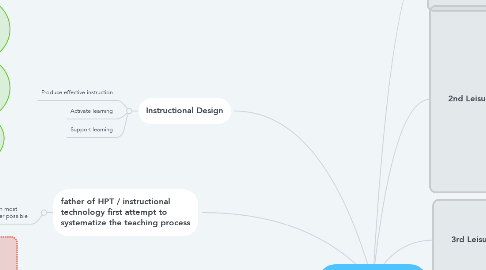
1. Human Performance Technology / Instructional Systems Development / Instructional Designer
1.1. ADDIE: Analysis, Design, Development, Implementation, Evaluation
1.2. Behavioral Psychology
1.2.1. goal of performance analysis is to determine the current state of performance and to understand what the level of performance could optimally be
1.2.1.1. Three categories influence human performance: 1. skill or knowledge, 2. the environment, 3. motivation
1.3. Constructivism: Learning is always a unique product "constructed" as each individual learner combines new information with existing knowledge and experiences
1.4. Roots: to teach workers how to perform their jobs more effectively in order to improve both organizational performance and worker satisfaction
1.4.1. B.F. Skinner
1.5. HPTs understand that humans do not perform in a vacuum -- that they operate in a "performance system"
2. Systems Approach Model
2.1. 1. Assess needs to identify goals
2.2. 2. Conduct instructional analysis
2.3. 3. Analyze learners and contexts
2.4. 4. Write performance objectives
2.5. 5. Develop assessment instruments
2.6. 6. Develop instructional strategy
2.7. 7. Develop and select instructional materials
2.8. 8. Design and conduct formative evaluation of instruction
2.9. 9. Revise instruction
2.10. 10. Design and conduct summative evaluation
3. father of HPT / instructional technology first attempt to systematize the teaching process
3.1. modify human capabilities in most effective and efficient manner possible
4. Instructional Design
4.1. Produce effective instruction
4.2. Activate learning
4.3. Support learning
5. Characteristics of Systems Model
5.1. components
5.2. input to components
5.3. output from components
5.4. all components are necessary
5.5. defined goal
5.6. feedback
6. Bob Mager
6.1. Objective lead to measurable outcome
7. Roger Kaufman
7.1. Needs Assessment
8. Behavior and accoomplishment
8.1. Behavior you take with you
8.2. Accomplishment you leave behind
8.2.1. Clear goals
8.2.2. Resources
8.2.3. Knowledge
8.2.4. Motivation
9. ID Theories
9.1. Cognitive Theory
9.2. Learning Theory
9.3. Motivational Theory
9.4. Social Learning Theory
10. 1st Leisurely Theorem
10.1. W=A/B or Worthy performance = ratio of valuable Accomplishment to costly Behavior
10.1.1. "It is the accomplishment we value and pay for."
10.2. Desired outcome of human competence --> leisure, i.e. time to do other things
10.2.1. innovation to help generate time to do other things
10.2.1.1. Leisure = Time x Opportunity
10.3. Behavior does NOT equal performance
10.3.1. worthy performance - worthy because the value of the accomplishment exceeds the cost of the behavior
10.3.1.1. Human competence is a function of worthy performance
10.3.1.1.1. It is all about outcomes. Focus on accomplishments.
11. 2nd Leisurely Theorem
11.1. PIP = Potential for Improving Performance
11.1.1. Wex/Wt or ratio of Exemplary performance over Typical performance
11.1.2. Causes of low PIPS: routine + repetitive jobs, exceptionally well-managed, extremely competitive + demanding, potentially life threatening
11.1.3. To determine PIP: 1. identify accomplishment, 2. determine hoe to measure accomplishment, 3. determine exemplary accomplishment, 4. measure actual accomplishment, 5 compare exemplary with actual accomplishment
11.2. competence is a social concept
11.3. actual performance -- GAP -- desired performance
12. 3rd Leisurely Theorem
12.1. Behavior = Environment x Performance or B = E x P
12.1.1. For any deficiency in accomplishment, the cause is always deficiency in behavior or environment
12.1.2. Behavior Engineering Model
12.1.2.1. Environment I Data (1) Instincts (2) Incentives (3)
12.1.2.1.1. Performance I Knowledge (4) Capacity (5) Motives (6)
13. 4th Leisurely Theorem
13.1. Perspective Theorem
13.1.1. Hierarchy of Values
13.1.1.1. Vantage Points Levels
13.1.1.1.1. Philosophical
13.1.1.1.2. Cultural
13.1.1.1.3. Policy
13.1.1.1.4. Strategic
13.1.1.1.5. Tactical
13.1.1.1.6. Logistic
